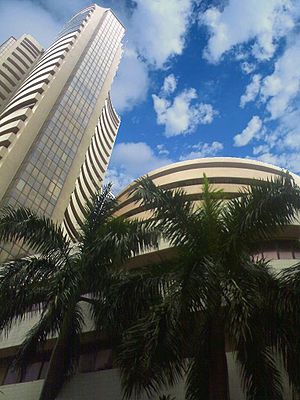 Image via Wikipedia
Image via WikipediaWhen a trader short sells shares he doesn't own, it's termed a naked short sale. SLBS allows the trader to borrow shares at the initiation of the short sale. This is called covered short selling and ensures that the trader fulfils his obligation by imposing adequate margins. Under the scheme, the lenders give their idle shares to short sellers for a period ranging from one month to a year, for a fee that is determined by demand and supply. This gives long-term investors an opportunity to earn additional income. SLBS is applicable in the cash market.
However, short-selling can also be done in the derivatives market. An investor can go short on a stock or market index by selling a futures contract or by buying a put option. Futures enable a trader to buy or sell a fixed quantity of stocks or index (defined in terms of market lots) within a specified period, while a put option grants its buyer a right to sell. So if XYZ stock is trading at Rs 100, the futures seller as well as the buyer of a 100 strike put option will gain if the price falls below Rs 100 on the date of settlement.
However, short selling via the derivatives market has some drawbacks compared with doing it through SLBS in the cash market. In the derivatives market, the futures and options (F&O) are traded in market lots, so one has to buy or sell the number of contracts specified in the rulebook. On the other hand, in SLBS, the market lot is one stock. So if a trader wants to sell ITC futures, he needs to trade in a market lot of 1,000 shares. This means a wrong judgment could magnify the losses for the trader. However, by using SLBS, he can choose to short sell only one stock. This safeguards him from the ill-effects of leverage.
Pros and Cons
SLBS helps in exploiting arbitrage opportunities between the cash and derivatives markets. When the futures are trading at a discount to the cash market, one can short sell the shares by borrowing them through SLBS while simultaneously buying the futures contract. Let's assume the stock of ABC is trading at Rs 200 in the cash market and at Rs 180 in the futures market. The market lot is 100 shares, while the market-determined cost of borrowing the shares through SLBS is Rs 5 per share. If we borrow shares in the cash market and sell them, and simultaneously buy the futures contract, it will entail a profit of Rs 2,000 [100 x (200-180)]. Even after paying Rs 500 as borrowing cost, we will generate Rs 1,500 as riskless profit.
Though SLBS seems beneficial, investors have ignored it and all efforts to garner their interest have failed. Between June 2009 and June 2010, there have only been 106 trades, amounting to a meagre Rs 6.42 lakh. The majority of the participants prefer the derivatives segment for short selling. According to experts, the reason for the lack of interest is the high cost associated with SLBS. According to Santanu Syam, Executive Director of Operations at Angel Broking: "A borrower needs to pay the full amount up front, besides additional margins. The sum of all margins works out to as high as 100 per cent or sometimes even more." Also, SLBS is applicable only to stocks that are traded in the F&O segment.
The system forces investors to shell out more than they need to pay in the derivatives segment. For example, if an investor wants to borrow 125 shares of Infosys at a price of Rs 2,600, it would involve a payment of Rs 3.25 lakh, plus the cost of borrowing. Also, margins such as cash margins are as high as 25 per cent of the lending price. So a short seller will need to pay Rs 4.06 lakh. In the derivatives segment, the investor will pay about 40 per cent margin (all inclusive).
Therefore, the same could be short sold with a margin of Rs 1.3 lakh. Short selling is beneficial when the markets are overvalued or when stocks are trading at unwarranted premiums over their fair values. Also, it enhances liquidity and provides stability to the stock markets. "To make the scheme more useful, the regulator should revise the margin requirement and introduce scrips other than those listed in the F&O segment," says Syam. Hopefully, the recent approval by SEBI to allow physical settlement in the derivatives segment will be the impetus that revives SLBS.
 Image via Wikipedia
Image via Wikipedia











